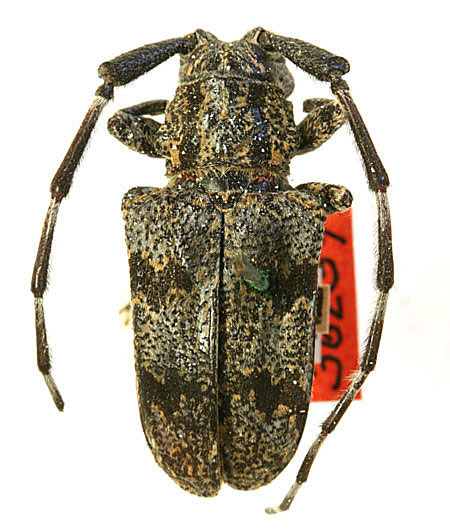
Superregnum: Eukaryota
Cladus: Unikonta
Cladus: Opisthokonta
Cladus: Holozoa
Regnum: Animalia
Subregnum: Eumetazoa
Cladus: Bilateria
Cladus: Nephrozoa
Cladus: Protostomia
Cladus: Ecdysozoa
Cladus: Panarthropoda
Phylum: Arthropoda
Subphylum: Hexapoda
Classis: Insecta
Cladus: Dicondylia
Subclassis: Pterygota
Cladus: Metapterygota
Infraclassis: Neoptera
Cladus: Eumetabola
Cladus: Endopterygota
Superordo: Coleopterida
Ordo: Coleoptera
Subordo: Polyphaga
Infraordo: Cucujiformia
Cladus: Phytophaga
Superfamilia: Chrysomeloidea
Familia: Cerambycidae
Subfamilia: Lamiinae
Tribe: Mesosini
Genus: Synaphaeta
Species: Synaphaeta guexi
Synaphaeta is a monotypic beetle genus in the family Cerambycidae first described by Thomson in 1864.[2] Its only species, Synaphaeta guexi (Also called the spotted tree borer), occurs in the Pacific states of North America, from British Columbia down to California.[3] It has been reared from a variety of hardwood trees, including Pacific willow (Salix lasiandra), white alder (Alnus rhombifolia), coffeeberry (Frangula californica), English walnut (Juglans regia), and cherry (Prunus sp.).[4] It was described by John Lawrence LeConte in 1852 based on a specimen from Benicia, California.[1][5]
References
LeConte, John L. (1852). "An attempt to classify the Longicorn Coleoptera of the part of America North of Mexico". Journal of the Academy of Natural Sciences of Philadelphia. 2 (2): 2 – via Biodiversity Heritage Library.
" Synaphaeta Thomson, 1864". BioLib.cz. Retrieved November 28, 2018.
"Synaphaeta guexi (LeConte, 1852)". Global Biodiversity Information Facility. GBIF Secretariat. Retrieved June 6, 2018.
Tyson, William H. (July 1966). "Notes on Reared Cerambycidae". The Pan-Pacific Entomologist. 42: 201–207 – via Biodiversity Heritage Library.
"Synaphaeta guexi (LeConte, 1852)". BioLib.cz. Retrieved September 8, 2014.a
Retrieved from "http://en.wikipedia.org/"
All text is available under the terms of the GNU Free Documentation License

